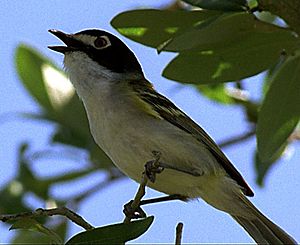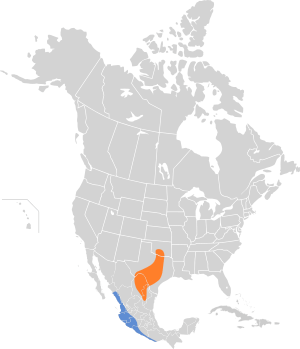Black-capped vireo facts for kids
Quick facts for kids Black-capped vireo |
|
|---|---|
 |
|
| Conservation status | |
| Scientific classification | |
| Genus: |
Vireo
|
| Species: |
atricapilla
|
 |
|
| Synonyms | |
|
Vireo atricapillus |
|
The black-capped vireo (Vireo atricapilla) is a small bird that lives in the United States and Mexico. This bird was once listed as an endangered species in the U.S. in 1987. Thanks to successful efforts by the U.S. Army at Fort Hood and Fort Sill, the black-capped vireo was taken off the endangered list in 2018. The IUCN now lists it as vulnerable, which means it still needs some protection.
Contents
What Does the Black-capped Vireo Look Like?
The black-capped vireo is a type of songbird. It is about 12 cm (4.5 inches) long.
Male and Female Birds
Adult males are olive green on their backs. Their undersides are white with light yellow on their sides. The top of their head is black. They have a white ring around their eyes and a black beak.
Female black-capped vireos are not as brightly colored as males. Their heads are more gray, and their undersides have a greenish-yellow tint.
Young Birds
Young males often have more gray on their heads. This makes them look a bit like adult females.
Building a Home: Black-capped Vireo Nests
Both male and female vireos work together to build their nest. They also share the job of sitting on the eggs.
Eggs and Chicks
Females usually lay three or four eggs. The eggs hatch after 14 to 17 days. The baby birds, called nestlings, stay in the nest for 10 to 12 days. The female bird keeps the young warm. The male bird brings most of the food to the nestlings.
Black-capped vireos can have more than one group of babies each breeding season. Sometimes, the male takes care of the first group of young birds. This lets the female build a new nest and lay more eggs, sometimes with a different male.
What Do Black-capped Vireos Eat?
These birds mainly eat insects. Beetles and caterpillars are a big part of their diet.
Where Do Black-capped Vireos Build Nests?
Black-capped vireos build their nests in "shinneries." These are brushy areas with scattered trees. They often use shin oak or sumac plants.
The height and thickness of the plants are important for nesting. The best nesting spots have leaves that reach all the way to the ground. Most nests are built between 15 and 50 inches (35–125 cm) off the ground. They are hidden by leaves so they are hard to see.
Sometimes, these birds nest on steep hillsides. Here, trees often grow in clumps and are not too tall. On flat ground, they prefer a mix of shrubs and small trees. These trees are usually about eight to 10 feet (2.5-3.5 m) tall. If too many trees grow very tall, the vireos will stop using that area.
Where Do Black-capped Vireos Live?
The black-capped vireo used to breed from Kansas, through Oklahoma and Texas, down to Mexico.
Current Range
Today, they breed from Oklahoma through the Edwards Plateau and Big Bend National Park in Texas. They also live in parts of Mexico. In Oklahoma, they are found in only a few counties.
Winter Homes
We do not know much about where these vireos spend the winter. Scientists think they might winter along the west coast of Mexico. This area stretches from southern Sonora to Guerrero.
Protecting the Black-capped Vireo
The black-capped vireo faces several threats.
Main Threats
One big problem is the brown-headed cowbird (Molothrus ater). Cowbirds are brood parasites. This means they lay their eggs in the vireo's nest. The vireo parents then raise the cowbird chicks instead of their own.
Other threats include people disturbing their habitats. Also, their homes are lost due to cities growing. Fires are sometimes stopped, which changes the habitat. Grazing animals and brush clearing also harm their homes.
Conservation Success
Today, there are tens of thousands of black-capped vireos. The Texas Parks and Wildlife Department and the Oklahoma Department of Conservation still manage the species. The U.S. Army continues to help protect these birds. This work helps the black-capped vireo stay healthy and safe.
See also
 In Spanish: Vireo cabecinegro para niños
In Spanish: Vireo cabecinegro para niños


